Roseau is the capital and largest city of Dominica, with a population of 16,571 as of 2023. It is a small and compact urban settlement, in the Saint George parish and surrounded by the Caribbean Sea, the Roseau River and Morne Bruce. Built on the site of the ancient Island Carib village of Sairi, it is the oldest and most important urban settlement on the island of Dominica.

Courtland is an incorporated town in Southampton County, Virginia, United States. It is the county seat of Southampton County.

The Hamptons, part of the East End of Long Island, consist of the towns of Southampton and East Hampton, which together comprise the South Fork of Long Island, in Suffolk County, New York. The Hamptons are a popular seaside resort and one of the historical summer colonies of the northeastern United States.

Southampton is a village in the Town of Southampton in Suffolk County, on the South Fork of Long Island, in New York, United States. The population was 3,109 at the 2010 census.
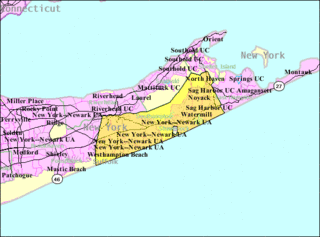
Southampton, officially the Town of Southampton, is a town in southeastern Suffolk County, New York, partly on the South Fork of Long Island. As of the 2020 U.S. census, the town had a population of 69,036. Southampton is included in the stretch of shoreline prominently known as The Hamptons.
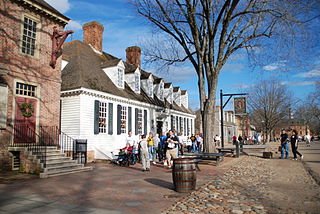
Colonial Williamsburg is a living-history museum and private foundation presenting a part of the historic district in the city of Williamsburg, Virginia. Its 301-acre (122 ha) historic area includes several hundred restored or recreated buildings from the 18th century, when the city was the capital of the Colony of Virginia; 17th-century, 19th-century, and Colonial Revival structures; and more recent reconstructions. The historic area includes three main thoroughfares and their connecting side streets that attempt to suggest the atmosphere and the circumstances of 18th-century Americans. Costumed employees work and dress as people did in the era, sometimes using colonial grammar and diction.

Historic Richmond Town is an authentic town and farm museum complex in the neighborhood of Richmondtown, Staten Island, in New York City. It is located near the geographical center of the island, at the junction of Richmond Road and Arthur Kill Road. Staten Island Historical Society and Historic Richmond Town are two different names for the same organization, reflecting its long history and evolution.

Old Sturbridge Village is a living museum located in Sturbridge, Massachusetts which recreates life in rural New England during the 1790s through 1830s. It is the largest living museum in New England, covering more than 200 acres. The Village includes 59 antique buildings, three water-powered mills, and a working farm. Third-person costumed interpreters demonstrate and interpret 19th-century arts, crafts, and agricultural work. The museum is popular among tourists and for educational field trips.

King Manor, also known as the Rufus King House, is a historic house at 150th Street and Jamaica Avenue in Jamaica, Queens, New York City. It was the home of Founding Father Rufus King, a signatory of the United States Constitution, New York state senator, and ambassador to Great Britain immediately after the American Revolution. Descendants of King's family lived in the house until 1896 when Rufus' granddaughter Cornelia King died and the house was sold to the Village of Jamaica. When the western half of Queens, including Jamaica, became part of the City of Greater New York, the house and the property were turned over to the New York City Parks Department which redesignated the land as Rufus King Park.
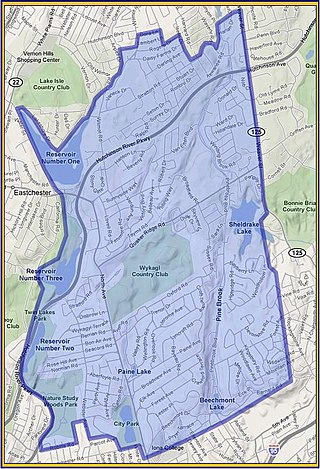
Wykagyl is a suburban community in New Rochelle, Westchester County, New York, United States. It is conterminous with ZIP code 10804, encompassing much of the city's 'North End'. According to Forbes, in 2010 Wykagyl's 10804 ZIP code, with a median home price of $806,264, ranked 333rd on its list of the 500 most expensive ZIP codes in the U.S. The Washington Post ranks Wykagyl among the nation's 650 Super Zips, or those with the highest percentile rankings for median household income and the share of adults with college degrees or higher.

Corwith Windmill at Water Mill is a historic mill on NY 27 and Halsey Lane in Southampton, New York.

The Christopher House is a stone masonry farmhouse at Historic Richmond Town in Staten Island, New York City. It is associated with two of the oldest Staten Island families. It was also used as a meeting place during the American Revolution, while being the residence of Joseph Christopher, a member of the Richmond County Committee of Safety from 1775-1776. It was moved to Historic Richmond Town in late 1969 and restored for museum presentation from 1975-1977.

The Golden Parsonage is a Grade II* listed country house in Great Gaddesden, Hertfordshire, and is part of the Gaddesden Estate. The house remains in the ownership of the Halsey Family.
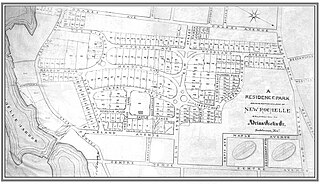
Residence Park is a historic community located in the city of New Rochelle, in Westchester County, New York. It is one of the first planned residential parks, and garden city communities, in the United States. It is located in the southern section of the city, bordered by Neptune Park on the west, Shore Road and Long Island Sound on the south, and Downtown New Rochelle on the north.
Sutton Manor is a distinctive early 20th century suburban residential district in the city of New Rochelle in Westchester County, New York. The neighborhood is located off the northern shore of Long Island Sound on Echo Bay. It was developed as an upper middle class enclave for families with heads of households employed in New York City and served as a model for the ideal suburban setting; harmonious architecture and exclusive amenities. The development appears to have been modeled on neighboring Larchmont Manor in the Town of Mamaroneck, yet on a smaller scale. That subdivision was conceived originally as an exclusive and convenient seasonal playground for New York’s wealthy upper classes, with its 6-acre waterfront park.

Edward Howell, Gent. (1584–1655), born in Marsh Gibbon, Buckinghamshire, was an English Puritan who settled at Lynn, Massachusetts in 1635. He was known for the founding of Southampton, New York with Edward Howell, Edmond Farrington, Edmund Needham, Abraham Pierson the Elder, Thomas Sayre, Josiah Stanborough, George Welbe, Henry Walton, Job Sayre, and Thomas Halsey in 1639/40.

Thomas Halsey was born 2 January 1591/2 in Hertfordshire, England and died 27 August 1678 in Southampton, New York. He emigrated from England in 1633 to New England, and eventually co-founded, with Edmond Farrington, Edmund Needham, Abraham Pierson the Elder, Thomas Sayre, Josiah Stanborough, George Welbe, Henry Walton, Job Sayre, and Edward Howell, the town of Southampton, New York in 1640.
Founded in 1916, the Columbia County Historical Society and CCHS Museum & Library collects, preserves, interprets, and presents the history, heritage, and culture of Columbia County, New York, and serves residents of all eighteen Columbia County towns and the city of Hudson.
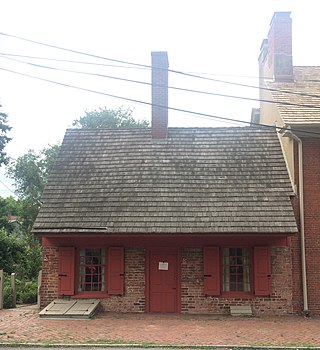
The Dutch House is a late-17th-century house in New Castle in the U.S. state of Delaware. Built during New Castle's colonial period, it is considered one of the oldest houses in the state. The house has been used for various purposes throughout its history, including as a rental property, storehouse, and historic house museum. The Dutch House is currently managed by the New Castle Historical Society.
Beaver Street is a street in the Financial District of Lower Manhattan in New York City. Beaver Street runs five blocks from Pearl Street in the east to Broadway in the west. Along its length, it crosses Hanover, William, Broad, and New Streets. The street is preserved as part of the New Amsterdam street grid, a New York City designated landmark.

















